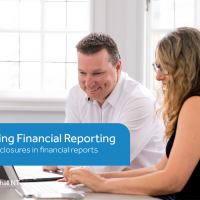The AASB is finalising its changes to the accounting by not-for-profit (“NFP”) entities for donations, grants, contributions and contract revenue through the introduction of two, as yet unnumbered, new standards:
- AASB 10XX Income of Not-for-Profit Entities; and
- AASB 2016-X Australian Implementation Guidance for Not-for-Profit Entities – Revenue from Contracts with Customers (AASB 15).
Together, these standards will change and clarify when a NFP entity obtains control of a resource and, hence, recognises an asset and when the receipt of that asset results in the recognition of income.
Key features:
- Generally, a resource controlled by a NFP entity is initially recognised at its fair value.
- Resources include physical, intangible and financial assets – whether acquired, donated or granted.
- A resource also includes the right to use an asset under a lease.
- Donation elements in below-market leases and loans are recognised as income at inception.
- Income recognition will more closely match recognition of related expenses.
- Capital grants are generally recognised as income as and when the asset is constructed or acquired.
Recognising the resource received
In essence, a NFP entity recognises an asset (which is defined as a resource obtained by the entity) when it obtains control of that resource. The asset received by the entity can take the form of cash; other financial assets such as bonds or shares in other entities; physical assets such as land & buildings; intangible assets such as intellectual property; and includes the right to use an asset under a lease. That asset is initially measured at its fair value.
Currently, a NFP lessee that pays either nominal or below-market lease payments in an operating lease would only recognise a lease expense based on those actual lease payments. Consequently, a NFP lessee would recognise neither an asset nor a lease expense in respect of leases where the payments were zero, nominal or ‘peppercorn’.
Furthermore, under existing standards, a NFP entity is only required to recognise acquisitions of property, plant and equipment or intangible asset at fair value where they are acquired at no or nominal consideration. Otherwise, those assets are recognised at their cost of acquisition.
However, under the new standards, those assets obtained by the NFP entity must be initially recognised at fair value. Hence, the entity will be required to:
- recognise an asset representing the below-market benefit (or donation element) received by the entity in relation to below market-rate leases; and
- consider whether a donation element exists within the acquisition price of other acquired assets. That is, whether the consideration paid is significantly less than the fair value of the acquired asset. In that scenario, the NFP will be required to recognise (donation) income for the difference between the fair value of the acquired asset and the consideration paid.
This new requirement to recognise the effects of below-market leases is a significant change from current practice and will require NFPs to consider whether their current lease arrangements will be affected.
Sometimes a customer may enter into a contract with a NFP entity with a dual purpose of obtaining goods or services and donating assets to the entity. The AASB debated whether donation elements should be separately identified and accounted for in all customer contracts. Identifying potential donation elements in all customer contracts involving NFPs would be unreasonably onerous. Finally, the AASB agreed to introduce a rebuttable presumption that the transaction price of a contract relates wholly to the satisfaction of performance obligations within the contract unless a separately identifiable component of the contract consideration is non-refundable.
For example, School A charges new students a non-refundable enrolment fee of $5,000 in addition to the term one tuition fee of $1,000. In this scenario, the presumption is rebutted because the enrolment fee is separately identifiable and non-refundable. Hence, the donation element of $5,000 is recognised by School A as income on receipt and tuition fees of $1,000 is recognised as income over time as it provides education services during term one. Alternatively, School B charges new students term one tuition fees of $6,000. In this case, the presumption is not rebutted because there is no separately identifiable non-refundable donation element. Consequently, School B recognises income of $6,000 over time as it provides education services during term one.
Recognising income
The general principle in AASB 10XX is that the entity recognises, as income immediately, the difference between the fair value of the asset received and any amount separately recognised as either:
- an equity contribution;
- revenue or a contract liability arising from a contract with a customer, in accordance with AASB 15;
- a lease liability arising in a lease contract;
- a financial instrument, in accordance with AASB 9 Financial Instruments; or
- a provision, in accordance with AASB 137 Provisions, Contingent Liabilities and Contingent Assets.
General gifts, donations and bequests or grants that do not impose specific stipulations on their use or contain refund obligations are not expected to give rise to a liability within the scope of AASB 9, AASB 15 or AASB 137. Hence, such amounts are recognised immediately as income when the entity obtains control of the asset.
However, to the extent that the transfer to the NFP either:
- is enforceable and contains specific and identifiable obligations that the NFP entity must perform;
- contains refund obligations if the funds are not expended, or the transferred asset is not used, in accordance with the specific conditions attaching to it; or
- gives rise to a constructive obligation by the entity,
the entity initially recognises a liability for that amount and will recognise income as or when those obligations are satisfied. In essence, to defer income recognition the entity must have enforceable performance obligations of sufficiently specificity to enable an assessment of whether, and when, the entity has satisfied those obligations. In the absence of those characteristics, income is recognised immediately.
Capital grants
The draft standards contain specific rules relating to capital grants. Where an entity receives a grant for the purpose of acquiring or constructing a non-financial asset to particular specifications or conditions (for example, a grant to construct low income community housing to government specifications), income is recognised as or when it satisfies its obligations to construct that asset.
Application
Although the new revenue standard, AASB 15 Revenue from Contracts with Customers will apply to for-profit entities from 1 January 2018, for not-for-profit entities both AASB 15 and the new NFP standards only apply to reporting periods beginning on or after 1 January 2019.
On transition to the new standards, a NFP entity can elect to apply the standards either:
- fully retrospectively; or
- on a modified retrospective basis from the beginning of the first year of adoption. Under this method there would be no restatement of comparative financial information.
Next steps
The AASB will issue final draft standards during September for a 30-day public comment period. The standards will contain a number of illustrative examples to assist entities apply the concepts in the standards. We encourage all NFP entities to provide the AASB with their views on the final drafts.
To find out how we can assist you analyse the effects of the new standards on your organisation, please contact Noel Clifford or your Nexia Edwards Marshall NT Advisor.


